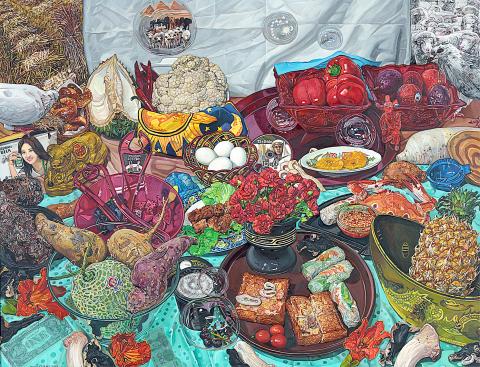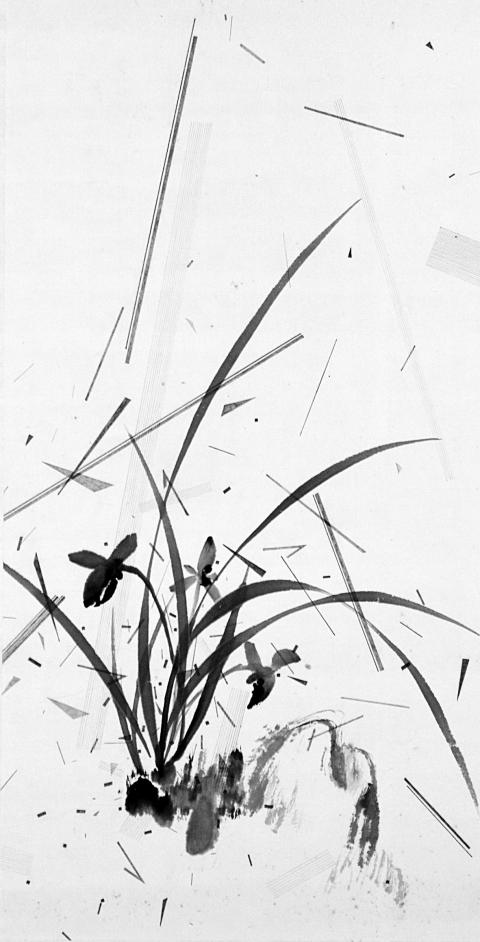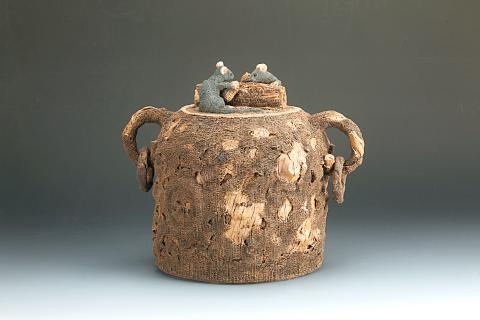Yeh Liu Chin-hsiung (葉劉金雄) makes remarkable artisan teapots, which are currently on view at The Heartfelt Teapots from Hsin-Wu Pottery House (心塢陶風). The studio is best known for its Withered Wood series (枯木系列), which feature “decayed” faux-wood surfaces realized with ceramics. The surfaces are pitted to mimic the effects of wind and rain, and the pots are fitted with operational handles and a spout. Born in Taoyuan County in 1945, Yeh Liu (葉劉) studied carving and painting at the National Academy of Arts and is recipient of the 2003 National Craft Award (國家工藝獎) for best ceramic work.
■ National Museum of History, 49 Nanhai Rd, Taipei City (台北市南海路49號), tel: (02) 2361-0270. Open Tuesdays to Sundays from 10am to 6pm. General admission: NT$30
■ Until Sept. 3

Photo courtesy of NTMFA
Dialogue among Bamboos (話竹) is a distinctly personal show, an artist’s tribute to her late grandmother. As a girl, Mia Wen-hsuan Liu (劉文瑄) lived with her grandmother, who loved traditional ink painting and pored over the works of the masters. “When I was a child there was a room specifically for my grandmother to work on her Chinese ink painting,” Liu writes in the gallery notes. “However … I hated ink painting so much when I was in high school.” As an adult and as an established painter, Liu returned to her grandmother’s faded ink paintings of bamboo fields with a pencil, adding texture and restoring colors that had been lost. The result is subtle iterations of ink and pencil lines on faded pages, an impressionist yet realist map tracking the passage of time.
■ Absolute Art Space (絕對空間), 11, Minsheng Rd Sec 1, Greater Tainan (台南市民生路一段205巷11號), tel: (06) 223-3508, open from Tuesdays to Fridays 12pm to 8pm and Saturdays and Sundays from 2pm to 8pm
■ Until July 20

Photo courtesy of Absolute Art Gallery
The National Art Exhibition (全國美術展) surveys last year’s best works of ink, calligraphy, seal-cutting, gouache, oil paintings, watercolors, prints, sculpture, photography and new media art, a total of 168 pieces chosen from 1,124 entries. Among them is Lin Hsing-an’s (林倖安) Five Desires: Hunger (五欲─食), an ink composition based on the daily changes of a spiderweb. Gold in the oil painting category went to Ho Huey-chih (賀蕙芝) for Joseph’s Dreams and the Storehouses (約瑟的夢與糧倉), about the Biblical story of Joseph. In Genesis, Joseph predicted that Egypt would be afflicted with famine and filled up a storehouse with grain for the future. In a luxuriantly detailed adaptation of the storehouse, the artist depicts what’s on the menu of Taiwan’s future: a case of Taiwan Beer, Chinese currencyu and a dollar bill, which make up coordinates of a tight triangle inscribing a bowl of sweet potatoes.
■ National Taiwan Museum of Fine Arts (NTMFA, 國立臺灣美術館), 2, Wuquan W Rd Sec 1, Greater Taichung (台中市西區五權西路一段2號) tel: (04) 2372-3552, open Tuesdays to Fridays from 9am to 5pm, Saturdays and Sundays from 9am to 6pm
■ Until Aug. 24

Photo courtesy of National Museum of History
A World Achieved (達境) is a solo show featuring American artist Li-lan Gee, daughter of the famed gallerist Helen Wimmer Gee and Asian-American modernist pioneer Yun Gee. The younger Gee developed a flexible and sensuous approach to geography, bringing together far-flung physical landmarks to create the condition of being in many places at once. The showcase features 23 pieces dating from 1970s to this year, including early experimentation with paper mail: collages of enigmatic stamps from nowhere and envelopes postmarked from far away. Gee also creates oil paintings on linen — minimalist landscapes of European architecture (populated with Japanese folk monsters) and a tiny East Asian courtyard with an outsized non-native insect. In each frame, Gee leaves wide sections of white space that imply a longing for distance from the world.
■ Tina Keng Gallery (耿畫廊), 15, Ln 548, Ruiguang Rd, Taipei City (台北市瑞光路548巷15號), tel: (02) 2659-0798. Open Tuesdays to Sundays from 10am to 7pm
■ Until July 27
Home is the subject of Homeland: Edge of Desolation (門外家園:荒蕪的邊緣), a collection of 34 installations and mixed-media installations by Hwang Buh-ching’s (黃步青). Some are based on Hwang’s boyhood memories of the ocean, others on the decline of humanist values in contemporary Taiwan. In a themed gallery titled Caring for the Environment, idiosyncratic mixed-media are an ode to wildlife in the deteriorating ecosystem. Born in 1948 in Lukang (鹿港), Hwang was trained at the University of Paris St. Denis and represented Taiwan at the 1999 Venice Biennale.
■ Museum of Contemporary Art, Taipei (MOCA, Taipei), 39 Changan W Rd, Taipei City (台北市長安西路39號), tel: (02) 2552-3720. Open Tuesdays to Sundays from 10am to 6pm. General admission: NT$50
■ Until Aug. 24

May 18 to May 24 Pastor Yang Hsu’s (楊煦) congregation was shocked upon seeing the land he chose to build his orphanage. It was surrounded by mountains on three sides, and the only way to access it was to cross a river by foot. The soil was poor due to runoff, and large rocks strewn across the plot prevented much from growing. In addition, there was no running water or electricity. But it was all Yang could afford. He and his Indigenous Atayal wife Lin Feng-ying (林鳳英) had already been caring for 24 orphans in their home, and they were in

President William Lai (賴清德) yesterday delivered an address marking the first anniversary of his presidency. In the speech, Lai affirmed Taiwan’s global role in technology, trade and security. He announced economic and national security initiatives, and emphasized democratic values and cross-party cooperation. The following is the full text of his speech: Yesterday, outside of Beida Elementary School in New Taipei City’s Sanxia District (三峽), there was a major traffic accident that, sadly, claimed several lives and resulted in multiple injuries. The Executive Yuan immediately formed a task force, and last night I personally visited the victims in hospital. Central government agencies and the

Australia’s ABC last week published a piece on the recall campaign. The article emphasized the divisions in Taiwanese society and blamed the recall for worsening them. It quotes a supporter of the Taiwan People’s Party (TPP) as saying “I’m 43 years old, born and raised here, and I’ve never seen the country this divided in my entire life.” Apparently, as an adult, she slept through the post-election violence in 2000 and 2004 by the Chinese Nationalist Party (KMT), the veiled coup threats by the military when Chen Shui-bian (陳水扁) became president, the 2006 Red Shirt protests against him ginned up by

As with most of northern Thailand’s Chinese Nationalist Party (KMT) settlements, the village of Arunothai was only given a Thai name once the Thai government began in the 1970s to assert control over the border region and initiate a decades-long process of political integration. The village’s original name, bestowed by its Yunnanese founders when they first settled the valley in the late 1960s, was a Chinese name, Dagudi (大谷地), which literally translates as “a place for threshing rice.” At that time, these village founders did not know how permanent their settlement would be. Most of Arunothai’s first generation were soldiers